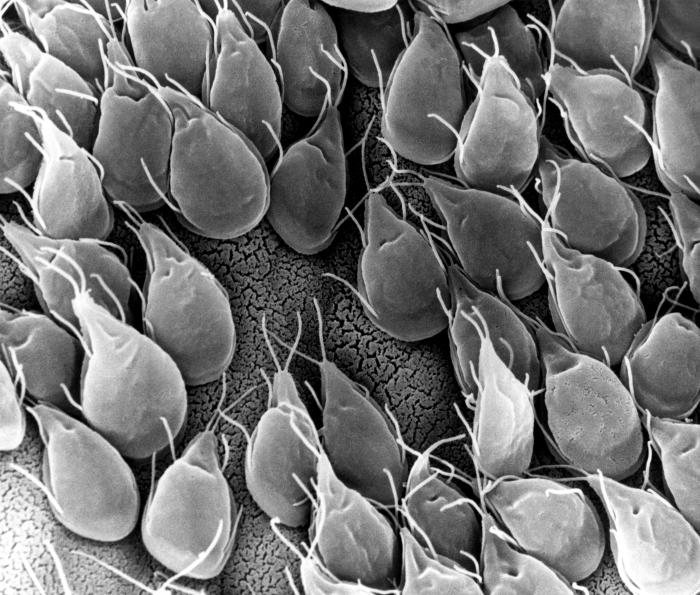Playlist
Show Playlist
Hide Playlist
Giardia lamblia – Protozoa (GI Infection)
-
03-52 Giardia lamblia.pdf
-
Download Lecture Overview
00:01 Giardia lamblia, a parasite. 00:03 Giardia lamblia is a flagellated protozoan parasite such as you see on the image on the screen. 00:11 It is transmitted as are most other parasites by fecal-oral spread of the cysts via contaminated water. 00:19 Incubation once one ingests the cysts typically takes up to 14 days but it can be almost quite immediate. 00:27 Diagnosis of Giardia is by demonstrating multinucleated cysts or the flagellated trophozoites in the stool. 00:36 We have a beautiful picture of a flagellated trophozoite by scanning electro-microscopy on the right side of the slide. 00:45 Stool antigen however is the more common mechanism of making the diagnosis and very reliable sensitive and specific antigen tests exists. 00:55 This is a complicated slide. 00:58 But let's look first at the processing of the cysts on the right side of the slide. 01:04 As with most other parasites, the initial step is to ingest a dormant cyst, a fully coated cyst and then at some point, in this case in the proximal duodenum, the cyst excysts itself, so it opens up to release the active trophozoites. 01:24 Then, while processing through the intestine, the trophozoite develops further maturation and then ultimately encysts itself and is expelled in the feces. 01:38 It’s the process during this intestinal passage that disease can occur if entrance into or through the intestinal mucosa also occurs. 01:49 So patients who are most susceptible then, looking at the slide bullet points on the left are - the ones who are most susceptible are those with underlying gut abnormalities or who actually have hypochlorhydria, those who are immunodeficient especially those who have a low level of immunoglobulin A, the mucosal antibody. 02:14 Patients who are blood group A positive which is interesting because it means they may express a specific binding site for the trophozoites to enter and cause disease. 02:27 Patients with malnutrition, possibly because they already have disordered gut integrity but also possibly because they are already in the little point nutritionally in any disease is sufficient for them to be negatively affected. 02:43 The cyst themselves are survivors, they resist heat and cold, they resist drying, they even are able to co-infect with other organisms so Giardia is absolutely a negative bad player in terms of parasitic disease. 03:02 Ultimately during that normal processing of the cyst through trophozoites back to cyst stage the trophozoite might adhere to the villi of the intestinal epithelium and then it releases proteinases which cause a physical injury at that site. 03:21 With physical injury comes reactive inflammation, reactive inflammation causes malabsorption, so one gets in effect a malabsorptive diarrhea. 03:31 Clinical manifestation of Giardia, after that very short incubation period, then one may have Giardia disease up to three weeks and it is very unpleasant. 03:43 The diarrhea, that malabsorptive diarrhea is of course very watery, very foul-smelling because one is unable to process those fats and even sometimes the proteins and so they all come out with secondary processing by normal bowel flora into a very foul-smelling mess. 04:01 Patients in addition will have nausea, anorexia, they’ll have diffuse abdominal cramps and bloating; they will certainly have a high amount of flatulence because, again, the normal flora bacteria have a lot of stuff to munch on and that processing of the fats releases a lot of gas and then of course, malabsorption has secondary affects for nutrition. 04:25 Treatment - metronidazole, not just an antibiotic which covers anaerobic bacteria but also a very effective treatment for amoebic disease and parasitic disease such as in this case the Giardia lamblia. 04:40 Secondarily, also tinidazole is also very effective amoebicidal drug and both have great efficacy in this case. 04:47 So in general, Giardia lamblia is a significant pathogen in the world. 04:54 It is present in many of the world's water supply and even if one thinks one is safe by living in a developed first world country, in fact, water supplies in wells can be highly contaminated by simple seepage of fecal infested water. 05:11 So drink carefully out there and watch carefully for Giardia.
About the Lecture
The lecture Giardia lamblia – Protozoa (GI Infection) by Sean Elliott, MD is from the course Parasites.
Included Quiz Questions
What is the incubation period of the causative organism if the stool examination of a patient with malabsorptive diarrhea reveals flagellated trophozoites?
- 1–14 days
- 14–28 days
- 21–35 days
- 2–4 weeks
- 30–45 days
Decreased production of which of the following components of the gastric juice increases the susceptibility of an individual to a symptomatic infection by Giardia lamblia?
- Hydrochloric acid
- Pepsinogen
- Rennin
- Intrinsic factor
- Mucus
Which of the following blood groups renders individuals more prone to the development of a symptomatic infection following ingestion of Giardia lamblia cysts?
- A positive
- B positive
- O positive
- O negative
- AB positive
Customer reviews
5,0 of 5 stars
| 5 Stars |
|
5 |
| 4 Stars |
|
0 |
| 3 Stars |
|
0 |
| 2 Stars |
|
0 |
| 1 Star |
|
0 |




